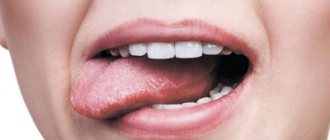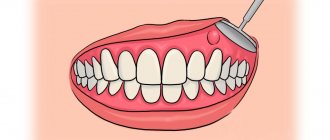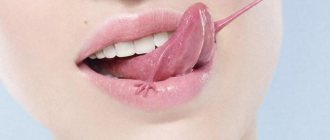Dental health is closely related to the health of your gums. If everything is fine with some, then the safest conditions in the oral cavity are created for others. However, with weakened, painful, often inflamed gums that are prone to bleeding and pain, serious dental problems can occur.
We often go to the dentist, get new fillings and treat dental caries, but we often forget about the health of our gums. They also need various preventive measures. First of all, care should be taken to strengthen them. We will tell you what safe methods can be used for this.
Don't forget to rinse after meals
Rinsing your teeth only during and after brushing is a big mistake. Any dentist will advise you to carry out this procedure more often, preferably after every meal.
Leftover food in the mouth can cause gum inflammation. Use plain water or special solutions.
Advice! It is especially important to rinse your mouth after eating sweets. Sugar can be the enemy of your teeth and gums. In just a few hours it creates a breeding ground for bacteria.
Ointments and gels
The main advantage of gels and ointments compared to rinses is their ability to remain longer on the surface of the gum mucosa - and, as a result, provide a therapeutic effect for a longer time. ASEPTA healing gel contains propolis, a component of natural origin that has antibacterial, anti-inflammatory and regenerating effects. Thanks to this, the gel, when used regularly, can eliminate almost all the unpleasant symptoms that accompany weakening gums, as well as have a positive effect on the condition of the tissues themselves. The product is applied twice a day to the affected areas (necessarily after thorough brushing of the teeth). After using it, do not consume food or liquid for half an hour. This gel allows you to quickly strengthen your gums at home.
An equally effective remedy is the adhesive balm ASEPTA. The sticky pectin base prevents saliva from washing off the balm from the surface of the mucous membrane - its antimicrobial effect lasts more than half an hour. The balm contains powerful antiseptic components - chlorhexidine and metronidazole, which can prevent the development of inflammatory gum diseases - gingivitis and periodontitis.
Use antiseptics for prevention
Antiseptic solutions are not suitable for continuous use. They are usually prescribed for the treatment of dental diseases, after tooth extraction or other complex operations in the oral cavity.
In addition, antiseptics are recommended for inflammation and bleeding gums to prevent the proliferation and increased activity of bacteria.
What antiseptics can be used to rinse your mouth?
- Furacilin. It is usually sold in the form of yellow tablets that need to be dissolved in a glass of water. The solution has a slight salty taste, usually does not cause irritation and does not increase gum inflammation.
- Miramistin. At the pharmacy, this product can most often be found in the form of a bottle of liquid. The box may contain special attachments. Miramistin solution has virtually no pronounced taste and does not cause discomfort.
- Iodinol. Sold in glass bottles, dark in color. A few drops of the product are mixed with water to obtain a solution. This drug has a pronounced antiseptic effect and a slight unusual taste. May slightly increase gum irritation if inflammation is present.
- Chlorhexidine. Sold in plastic bottles. The solution based on this drug has a mild medicinal aftertaste. Inflammation usually does not increase after use.
Methods and methods for self-treatment of gums at home
If you cannot make an appointment with a dentist to treat your gums, self-treatment of your gums should be done in stages. First of all, it is necessary to relieve pain, then swelling and bleeding in the gums. You can prepare a remedy for gum inflammation yourself. An effective natural remedy for sore gums must be fresh, its shelf life does not exceed 24 hours after brewing. For self-treatment of gum inflammation, you can use decoctions, infusions, ointments, fresh extracts and plant oils. Medicinal products for strengthening gums and teeth are used as solutions for mouth rinsing and as solutions for applications, which should remain in the diseased gums for a certain time, about 20 minutes. The herbs included in the gum rinse for inflammation can be either fresh or dried. Rinse for teeth and gums during inflammation should be regular, preferably at the same time, throughout the entire period of treatment. On average, a course of gum treatment with folk remedies takes 1 – 2 weeks.
General scheme (method) for treating gums at home:
- First we remove swelling and inflammation.
- This requires astringents and antibacterial agents. For example: rinsing with saline solution 2 times a day, calamus root infusion 2 times a day, oak bark decoction 2 times a day, hydrogen peroxide 2 times a day. After each rinse, apply amaranth oil to the sore gum for 20 minutes.
- After 4 - 6 days we change the drugs.
- As the swelling and inflammation subside, keratoplasty drugs are needed. If there is no allergy, we use fresh propolis (not an alcohol tincture of propolis, but propolis oil) for applications to the gums 2 times a day in the morning and evening, during the day we apply sea buckthorn or rosehip oil. We also continue to use amaranth oil, but now in addition to compresses on the gums, also 1 tablespoon inside in the morning and evening.
If the cause of inflammation of the gums is a sore tooth, then swelling of the gums can develop into periostitis (flux), and pus accumulates in the mouth under the gum. This condition is life-threatening, because the spread of pus can go into the internal cellular spaces of the neck and floor of the mouth and be complicated by phlegmon. Such purulent processes are accompanied by high fever, weakness and dizziness, sweating and chills. Therefore, if you are in the city, be sure to consult a doctor. If you are hiking in the forest or mountains and there is no doctor, you need to take broad-spectrum antibiotics or fluoroquinolones (for example, Rulid, Avelox) and, if possible, ensure evacuation by the police or the emergency services of the Ministry of Emergency Situations to the maxillofacial department of the hospital.
Ask a question!
8
We'll call you back in 1 minute
Hydrogen peroxide solution for rinsing
What strengthens weak gums due to bleeding caused by removable acrylic dentures? This is the well-known and accessible hydrogen peroxide! Prepare a mouth rinse solution. You will need hydrogen peroxide (you can buy it at a pharmacy, usually a 3% solution) and water. Add a tablespoon of peroxide to a glass of water. The solution is ready. Rinse throughout the day, three or four times will be enough.
Oak bark for gums: a homemade recipe
Oak bark is one of the remedies that helps to effectively and in a short period of time get rid of bedsores and ulcers caused by wearing dentures and other problems associated with the gums and oral mucosa. In order to prepare the decoction you will need 500 grams of water and oak bark, about 2 tablespoons (pre-grind). Cook the bark over low heat for a quarter of an hour. Leave for 20 minutes. Rinse your mouth with the strained solution.
Rinse with soda for gum inflammation
Baking soda is useful for treating gums at home. We will prepare a soda-based rinse solution. You will need 200 grams of water, a teaspoon of soda, a pinch of salt and a sage decoction (about 50 grams). Mix the ingredients. Rinse at least four times a day.
Herbal rinse solution
If gums are bleeding due to the edges of metal-ceramic crowns, the following solution may be useful: you will need a spoonful of the following herbs: St. John's wort flowers, elderberry and strawberry leaves. Boil the mixture over low heat for 15 minutes, remove from heat. Infuse the decoction for 40 minutes. Rinse your mouth every 2 hours during the day.
Rinse your mouth with St. John's wort infusion
Take a spoonful of herbs, pour boiling water, 200 grams will be enough. Leave for 40 minutes. Strain and rinse your mouth.
Aloe for gum inflammation
Aloe compress: wash the plant leaf, remove the thorns and cut lengthwise. Apply to gums for 15 minutes.
Saline gum rinse
To prepare, you will need salt (it is better to use sea salt), one tablespoon and water, approximately 150 grams. Rinse your mouth with the solution a couple of times a day. You can simply rub salt into your gums. Sea salt relieves inflammation.
Chamomile and calendula for gum inflammation
Self-treatment of gums at home - chamomile and calendula. These plants relieve inflammation well. To prepare the infusion, you will need a tablespoon of chamomile or calendula, pour boiling water over the herb (a glass will be enough). Let it brew. Strain. Alternate infusions.
Let's prepare an infusion of pine buds for gums
To prevent gum inflammation when wearing zirconium crowns, we prepare an infusion of pine buds. This relieves redness and inflammation from irritated areas of the gums. You will need a tablespoon to chop the kidneys. Pour water (you will need half a liter) and boil for 10 minutes. Leave for an hour. Rinse with strained infusion.
Propolis: alcohol tincture for gums
Treatment of gums at home is also possible with an alcoholic infusion of propolis. Add 20 drops of tincture to a glass of warm water and you can begin the rinsing procedure.
Calamus root
To prepare a solution for rinsing, you will need calamus root (a tablespoon of crushed), pour boiling water (200 grams). Let it brew and you can use it. This type of solution copes with inflammation and removes unpleasant odor from the mouth or from under dental crowns.
Honey + salt
One of the well-known and useful methods of relieving inflammation is a mixture of honey and salt (preferably sea salt, of course). To prepare, you will need a spoon of honey and 4 tablespoons of salt. Mix all ingredients. Rub the mixture onto problem areas of the gums.
Black radish
You can treat gums at home at any time. If you have black radish at home, then this is a great way to get rid of bleeding gums. Extract the juice from the fruit and rinse your mouth with it.
Decoction: linden flowers and oak bark
To prepare an effective decoction you will need two tablespoons of crushed oak bark and a spoonful of linden flowers. Mix everything, you get a mixture. Take a spoonful of the mixture and fill it with water (200 grams will be enough). Let it boil for 2 minutes, leave for 20 minutes. Rinse your mouth with warm, strained broth. Thanks to oak bark, the effect will be noticeable after the first procedure.
Nettle leaf decoction for gums
Let's prepare an infusion (decoction) of nettle leaves. You can use fresh or dry leaves and the effect is the same. Just be careful when chopping fresh leaves. To prepare, you will need to pour a spoonful of crushed leaves of the plant with water (200 grams of boiling water). Leave the solution for 30 minutes. Rinse your mouth at least three times a day. To avoid treating inflammation and bleeding gums, eat more vegetables and fruits. Watch your diet. Do not abuse alcoholic drinks and smoking. Be sure to use dental floss after eating or simply rinse your mouth well. Remember that oral hygiene in the morning and evening will help avoid problems with gums and teeth. You can use gum treatment at home, that is, traditional methods, together with medications.
This article is for informational purposes only and does not encourage you to treat your gums at home. We strongly recommend using the recipes described above only after consulting a doctor.
Our doctors
Brodsky Sergey Evgenievich
Deputy Chief Physician, Candidate of Medical Sciences, specialties: dentistry and medical microbiology.
Work experience: since 1999.
Salatsky Dmitry Nikolaevich
Chief physician, orthopedic dentist, gnathologist, maxillofacial prosthetist.
Work experience: since 1988.
Kolikov Dmitry Vladimirovich
Dentist, implant surgeon, orthopedist, therapist
Work experience: since 1999
Skranzhevskaya Svetlana Vladimirovna
Hygienist, dental assistant
Work experience: since 1994
Seredin Evgeniy Vasilievich
Implant surgeon
Work experience: since 2004
Malanova Olga Andreevna
Dentist, orthodontist, therapist
Work experience: since 2016
Rybakova Tatyana Evgenevna
Dentist-therapist-endodontist
Work experience: since 2006
Molodtsov Dmitry Evgenievich
Osteopathic dentist
Work experience: since 1998
Artemyeva Oksana Alexandrovna
Orthopedic dentist, therapist
Work experience: since 2001
Just pick up the phone and call us!
8
We will definitely make you an offer that you cannot refuse!
Fight bleeding gums
If the slightest mechanical impact causes pain and easily injures the gums, causing bleeding, then this cannot be considered a normal phenomenon.
First, you need to contact your dentist and find out the cause of bleeding and weak gums. Secondly, you need to use comprehensive methods to treat them and eliminate the problem.
Causes associated with dental diseases
The cause of loose teeth in the gums can be various dental diseases, such as periodontitis, periodontal disease, periodontitis and gingivitis. Incorrect bite can also trigger the appearance of this disease.
With gingivitis, many bacteria live in the oral cavity, which cause bleeding gums and, as a result, loosening of teeth.
With periodontitis, the same symptoms are present, but they are also accompanied by bad breath and inflammatory processes in the gums begin. The cause of both diseases is poor oral hygiene.
Periodontal disease is not associated with inflammatory processes and is accompanied by a decrease in the bone walls between all teeth, resulting in bleeding and itching in the gums, and the teeth become mobile and their sensitivity increases.
Massage your gums to improve blood circulation
Strengthening your gums is not just about using toothpastes and rinses. Gums need normalization of blood circulation. This requires a massage. It can be done using circular movements with your fingers or a soft toothbrush.
You can also find special brushes for gum massage on sale. By improving blood circulation, you can strengthen them over time and prevent many complications.
Diet and vitamins
Proper, balanced nutrition is necessary for gum health. To strengthen the mucous membranes and blood vessels, you need to eat foods high in vitamin C, such as citrus fruits and green leafy vegetables. Vitamin K, found in large quantities in green vegetables and herbs, has a similar effect. Antioxidants and tannins contained in green tea and red wine have an anti-inflammatory and healing effect, slowing down the aging process. In addition, it is important to consume enough phosphorus, calcium and zinc - they are contained in seafood, garlic and onions, and dairy products.
Vitamin complexes are well suited as an additional source of nutrients - in particular, the vitamin-mineral complex for teeth ASEPTA. It contains vitamins A, B3 and B6, C, D3, as well as coral calcium and green tea extract. In addition, coenzyme Q10, which is contained in the complex, has a powerful regenerating effect and restores damaged gum tissue.
Oils
In the treatment of periodontal disease, applications with sea buckthorn oil have a good effect. It is enough to twist a piece of bandage or cotton wool, dip it in oil and apply to the inflamed area for no more than 10 minutes, 2 times a day. If necessary, the procedure must be repeated daily for up to two weeks.
Fir oil will have no less effect. Usually it is mixed with fish oil or olive oil, applied to gauze and massaged into the gums for several minutes.
For massage it is good to use a solution of tea tree oil. A few drops of this essential oil are applied to the thumb and index finger and intensively massage the gums from the outside and inside for several minutes.
Apply a few drops of lemon, fir and eucalyptus oils to a gauze swab. Massage the area affected by periodontal disease for 5 minutes in the evening before bed after hygienic brushing of teeth.
Compresses
Compresses using medicinal herbs have a rapid anti-inflammatory effect, relieve bleeding gums and improve blood supply to the periodontium.
Highlander
An infusion of Polygonum is one of the popular folk recipes for the treatment of abscesses due to periodontal disease. Pour one teaspoon of herb into a glass of boiling water. Leave in a dark place for a couple of hours and the infusion is ready. This infusion is used for compresses only when hot. Soak a gauze pad generously with the solution and apply to the affected gums for 30 minutes. The procedure is repeated every other day until the symptoms of the disease disappear.
Plantain
Plantain is well known for its healing effect. It is especially useful to grind fresh leaves of the plant and apply the resulting pulp to the gums for 10-15 minutes. It is advisable to repeat the procedure up to three times a day. You can simply rub plantain juice into the affected areas.
Nettle
Nettle helps with bleeding gums. For a glass of boiling water, two or three teaspoons of dry herbs will be enough. It infuses for no more than half an hour. The strained solution is applied to sterile cotton wool, which is then applied to the gums. After 15 minutes, the compress is removed. The procedure must be repeated up to 3 times a day every day. The course of treatment is 14 days.
Aloe
To prepare a compress, you need to cut a fresh aloe leaf, rinse well and cut lengthwise. Apply it to the gum at night for 10 evenings in a row and it will heal.
There is another less pleasant, but more effective way to use aloe against periodontal disease. You need to chop a medium onion and 2-3 aloe leaves. This paste should be applied to a gauze pad and pressed firmly onto the area of inflammation. After the procedure, you should not eat, just rinse your mouth with sage infusion or saline solution. The duration of the method is 10 days.
Beet
Wash and peel fresh beets, peel and grate using the finest grater. Mix the resulting slurry with olive (or vegetable) oil in a 1:1 ratio. Apply the mixture to your gums and keep for at least 15 minutes. Repeat the procedure regularly several times a day for the purpose of treatment, and to prevent periodontal disease, use beets several times a month.
Differences between periodontal disease and periodontitis
Patients often confuse the names, and therefore turn to dentists, complaining of periodontal disease. In 90-93% of cases, ordinary periodontitis is detected. It is widespread. Our disease is rare.
Periodontitis manifests itself through:
- pain on palpation, when brushing teeth;
- bleeding;
- redness of the gum margin;
- swelling;
- cyanosis.
In severely advanced cases, there may also be headaches, fever and severe toothache. All this leads to refusal of food and hygienic cleaning of the oral cavity.
By place of development:
- localized - a small lesion affecting only one tooth; often results from mechanical damage to tissue;
- generalized - damage to several teeth also affecting the gingival and bone tissue.
According to the nature of the course:
- acute - characterized by sudden pain attacks and rapid development of symptoms;
- chronic periodontitis is the transition of untreated acute periodontitis to a chronic form, in which pain and other symptoms practically disappear, but the disease progresses and deforms the tissue.
Where can I buy
Traditional herbal medicine puts forward high quality medicinal raw materials as the main requirement for independent production of medicines. High-quality folk remedies in finished form, as well as ingredients for their preparation, are offered by the Russian Roots online store. Delivery of ordered goods in Moscow and the Moscow region is carried out by couriers, and in other regions by mail. You can also purchase the required product in our herbal pharmacies in Moscow.
Attention! All materials published on our website are protected by copyright. When re-publishing, attribution and a link to the original source are required.
Classification of gum inflammation
There are several classifications of the disease:
According to the current, the following types of gingivitis are distinguished:
- acute – severe inflammation of the gums occurs, which is accompanied by bleeding and pain;
- chronic - the disease occurs cyclically, periods of relative calm are replaced by exacerbation of gingivitis, which most often occurs in winter and spring, when the body is most weakened.
Based on the nature of the lesion, the following types of gingivitis are distinguished:
- catarrhal;
- hypertrophic;
- atrophic;
- ulcerative;
- ulcerative-necrotic.
Severity of gum inflammation:
- mild – the interdental papillae are mainly affected, the disease is mild and usually ends with complete recovery;
- medium - in addition to the interdental papillae, the pathological process involves the marginal parts of the gums;
- severe - inflammation covers the entire gum, including its alveolar part.
Based on localization, the following types of gingivitis are distinguished:
- localized – one or more areas of the gum are inflamed;
- generalized – the entire gingival space of one or both jaws is affected.
Treatment of gum inflammation
Catarrhal gingivitis is usually a complication of infectious diseases (diphtheria, measles, scarlet fever and a number of others), therefore, diagnostic measures are first carried out to identify the underlying pathology.
Local treatment is to relieve swelling and redness, relieve gum pain, and prevent secondary infection. In children, the catarrhal form of the disease is treated with plant phenolic compounds, multivitamin complexes, and anti-inflammatory steroids.
The choice of treatment regimen for hypertrophic gingivitis depends on the severity of the disease and the severity of symptoms. Quite often, the help of related specialists (endocrinologist, psychoneurologist) is required. In addition, it is necessary to eliminate local provoking factors (bad fillings, tartar, malocclusion and a number of others).
The main stages of treatment of hypertrophic gingivitis are the elimination of exudative phenomena and the removal of inflammation. For this purpose, the use of anti-inflammatory drugs, hygiene products, and NSAIDs is indicated.
In addition, patients are prescribed herbal astringents and antibacterial drugs (decoction of nettle leaves, yarrow, sage and a number of others).
In the ulcerative-necrotic form of the disease, necrosis of the gum tissue occurs, and the inflammatory process penetrates into the deep tissues. Treatment in this case is prescribed depending on the severity of the pathological process, the age of the patient, and the type of pathogen.
Patients are advised to drink plenty of fluids to quickly remove toxins from the body, a diet rich in vitamins, microelements, proteins, and antihistamines. In particularly severe cases, surgery may be required.
Toothpaste for strengthening gums
Therapeutic and prophylactic toothpastes are also an excellent tool for combating looseness of gingival tissue. Proper brushing of teeth is effective in itself - by massaging the gums with a brush, we improve blood circulation in the tissues and remove plaque, which is a constant source of infectious danger. In addition, many pastes contain antiseptic components that kill pathogens. However, it should be remembered that such pastes cannot be used for a long time, as this may negatively affect the state of the natural microflora of the teeth.
For regular use, pastes based on natural ingredients are better suited. For example, ASEPTA and ASEPTA Sensitive toothpastes contain extracts of calendula, sage, St. John's wort, sweet clover, calamus and other medicinal plants that relieve inflammation, eliminate bleeding and have a mild antiseptic effect. ASEPTA Sensitive paste also contains minerals - potassium citrate and hydroxyapatite, which increase the resistance of teeth to caries.










